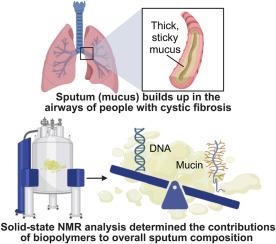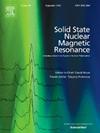囊性纤维化患者痰液的固态核磁共振成分分析。
IF 2.4
3区 化学
Q4 CHEMISTRY, PHYSICAL
引用次数: 0
摘要
患有遗传性疾病囊性纤维化(CF)的人经常会出现慢性气道感染,并产生称为痰的气道分泌物。我们需要更好地了解痰液的成分,以便跟踪对囊性纤维化治疗药物的反应变化,并改进研究囊性纤维化气道感染的实验室模型。糖基化蛋白质粘蛋白是痰液的主要成分。粘蛋白与细胞外 DNA 一起造成了痰液的高粘弹性,从而抑制了气道清除,并被认为促进了 CF 患者的慢性气道感染。过去对痰液成分的研究发现,痰液中还含有其他生物分子成分,包括其他糖基化和非糖基化蛋白质、游离氨基酸和脂质。通常情况下,对痰以及其他复杂生物材料的研究主要集中在可溶性或分离成分上。固态 NMR 并不局限于研究可溶性成分。相反,它可以提供不溶性生物样本的分子级信息。此外,固态 NMR 无需对样品进行任何处理即可提供有关样品成分的信息,从而消除了因样品不溶解或在分离步骤中可能丢失样品而导致对某些成分估计错误的可能性。在本研究中,我们使用 13C 和 31P CPMAS 研究了六名 CF 患者痰样本的总成分。我们将这些光谱与市售粘蛋白、DNA 和磷脂样本的光谱进行了比较。最后,我们还进行了补充生化分析,以确定痰样本中存在的特定蛋白质。总之,我们的研究结果让我们深入了解了 CF 患者未经处理的痰样本的成分,可作为今后研究 CF 和 CF 患者气道感染的基准。此外,这项研究还为扩展固态核磁共振方法提供了机会,使之包括动态核偏振(DNP),从而获得痰和无法进行同位素富集的类似生物样本的高分辨率信息。本文章由计算机程序翻译,如有差异,请以英文原文为准。

Solid-state NMR compositional analysis of sputum from people with cystic fibrosis
People with the genetic disease cystic fibrosis (CF) often have chronic airway infections and produce airway secretions called sputum. A better understanding of sputum composition is desired in order to track changes in response to CF therapeutics and to improve laboratory models for the study of CF airway infections. The glycosylated protein mucin is a primary component. Along with extracellular DNA, mucin gives rise to the high viscoelasticity of sputum, which inhibits airway clearance and is thought to promote chronic airway infections in people with CF. Past studies of sputum composition identified additional biomolecular components of sputum including other proteins, both glycosylated and not glycosylated, free amino acids, and lipids. Typically, studies of sputum, as well as other complex biological materials, have focused on soluble or isolated components. Solid-state NMR is not limited to the study of soluble components. Instead, it can provide molecular-level information about insoluble biological samples. Additionally, solid-state NMR can provide information about sample composition without requiring any processing of the sample, eliminating the possibility of misestimating certain components due to insolubility or potential sample loss in isolation steps. In this study, we used both 13C and 31P CPMAS to investigate the total composition of sputum samples obtained from six people with CF. We compared these spectra to those of commercially available mucin, DNA, and phospholipid samples. Lastly, we performed complementary biochemical analyses to identify specific proteins present in the sputum samples. Overall, our findings provide insight into the composition of unprocessed sputum samples from people with CF, which can be used as a benchmark for future investigations of CF and infections in the airways of people with CF. Further, this study provides opportunities to expand the solid-state NMR approach to include dynamic nuclear polarization (DNP) to obtain high-resolution information of sputum and similar biological samples that are not feasible to isotopically enrich.
求助全文
通过发布文献求助,成功后即可免费获取论文全文。
去求助
来源期刊
CiteScore
5.30
自引率
9.40%
发文量
42
审稿时长
72 days
期刊介绍:
The journal Solid State Nuclear Magnetic Resonance publishes original manuscripts of high scientific quality dealing with all experimental and theoretical aspects of solid state NMR. This includes advances in instrumentation, development of new experimental techniques and methodology, new theoretical insights, new data processing and simulation methods, and original applications of established or novel methods to scientific problems.

 求助内容:
求助内容: 应助结果提醒方式:
应助结果提醒方式:


